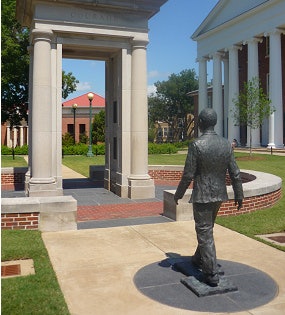 The statue commemorates James Meredith becoming the first Black student to enroll in then all-White University of Mississippi during the fall of 1962.
The statue commemorates James Meredith becoming the first Black student to enroll in then all-White University of Mississippi during the fall of 1962.OXFORD, Miss. ― The FBI on Tuesday was helping investigate who tied a noose around the neck of a University of Mississippi statue of James Meredith, who, in 1962, became the first Black student to enroll in the then all-White southern college.
University police found the rope noose and a pre-2003 Georgia state flag with the Confederate “stars and bars” on its face Sunday morning, said campus police Chief Calvin Sellers. Two men were seen near the statute early Sunday and investigators were looking at surveillance footage.
The Ole Miss Alumni Association is offering at $25,000 reward for information leading to an arrest.
“It’s a racial hate crime,” Mississippi NAACP president Derrick Johnson said Tuesday after a news conference at the state Capitol. “At what level do they get prosecuted? I don’t know. But as long as we tolerate hate, we will continue to revisit history and the past of this state, and at some point we must move forward.”
In a statement, Chancellor Dan Jones condemned the action as contrary to the beliefs and values of the university community.
“These individuals chose our university’s most visible symbol of unity and educational accessibility to express their disagreement with our values,” Jones said. “Their ideas have no place here, and our response will be an even greater commitment to promoting the values that are engraved on the statue ― Courage, Knowledge, Opportunity, and Perseverance.”
University police asked for the FBI’s help, said Deborah R. Madden, a spokeswoman for the Mississippi FBI office in Jackson.
Johnson said there is an overall problem at Ole Miss.
“You cannot have a university where, when you turn down the main drag, it’s called Confederate Drive. … At some point, we’re going to have to reverse course on the image of Ole Miss so we can reverse course on the image of the state of Mississippi,” he said.
When Meredith tried to enter Ole Miss in fall 1962, Mississippi’s governor tried to stop him and led to rioting on the Oxford campus. U.S. Attorney General Robert Kennedy sent 500 U.S. Marshals to take control and a couple weeks later, Meredith was allowed in the school. Though he faced harassment during his time at the school, he graduated with a degree in political science.
Assistant to the Chancellor for Multicultural Affairs Don Cole reiterated the creed that the university stands by.
“This is particularly painful because the James Meredith statue has become a gathering place for students to discuss many things, including the tenets of our creed, which calls for dignity and respect for all people,” he said.





















